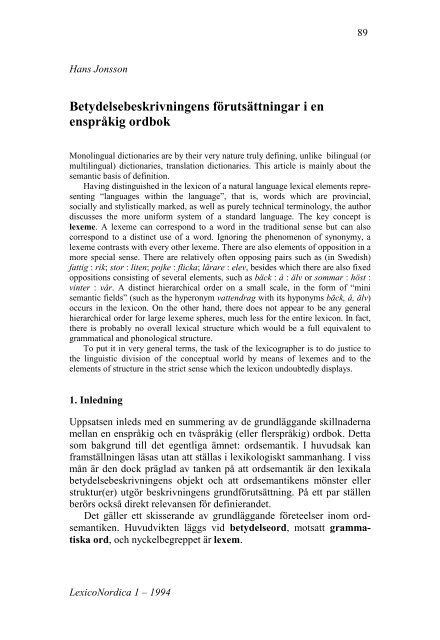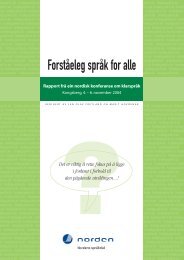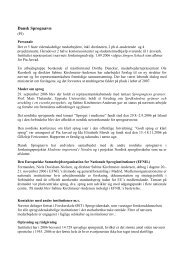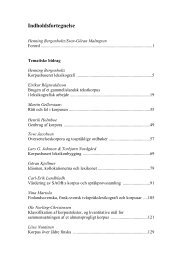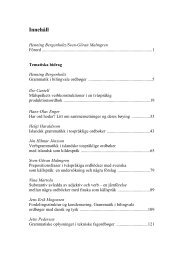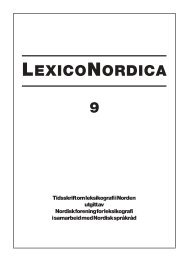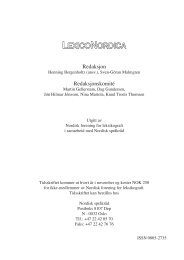- Page 1 and 2:
Indholdsfortegnelse Indledende bidr
- Page 3 and 4:
Pia Virtanen: Zur Geschichte der fi
- Page 5 and 6:
Henning Bergenholtz/Sven-Göran Mal
- Page 7 and 8:
temaemne være velkommen. Ud over t
- Page 9 and 10:
forledd viser til sammen at det har
- Page 11 and 12:
synonymprinsippet. Det tas stadig i
- Page 13 and 14:
funnsrettede leksikografi, for å i
- Page 15 and 16:
Litteratur: Algeo, John 1989: Dicti
- Page 17 and 18:
Henning Bergenholtz Faglige oplysni
- Page 19 and 20:
er hans hovedanke de tilfælde af u
- Page 21 and 22:
fremstilling - svarende til den på
- Page 23 and 24:
2. Der er ingen helt klar skillelin
- Page 25 and 26:
denne titel bliver klar. Brugeren a
- Page 27 and 28:
kantor i den prot. og jød. kirke d
- Page 29 and 30:
ganske vist rigtigt, men kan næppe
- Page 31 and 32:
Schülern. Hrsg. von H.H. Munske et
- Page 33 and 34:
del lesing i forbindelse med define
- Page 35 and 36:
Disse ordbøkene hadde klare religi
- Page 37 and 38:
tegnet i 1952 på initiativ fra UNE
- Page 39 and 40:
oppgir at den i det store og hele e
- Page 41 and 42:
fag som er mer utsatt for kommersia
- Page 43 and 44: formene (1991), slik de finnes i Bo
- Page 45 and 46: konvensjonalisert, men det har vær
- Page 47 and 48: Bokmålsordboka = B. Wangensteen/M.
- Page 49 and 50: Martin Gellerstam Produktionsordbö
- Page 51 and 52: Inlärningsordböckerna lever upp t
- Page 53 and 54: denna?) i sin nuvarande form är id
- Page 55 and 56: analys. Kanske skall man se detta v
- Page 57 and 58: sättningar som ligger vid sidan av
- Page 59 and 60: Stora svensk-engelska ordboken. Sto
- Page 61 and 62: institution. Då behovet av en mode
- Page 63 and 64: använda och användbara ord, vid b
- Page 65 and 66: att öka. Nykysuomen sanakirja hade
- Page 67 and 68: slagsord. Ungefär hälften så sto
- Page 69 and 70: Petter Henriksen Encyklopediens rol
- Page 71 and 72: nasjonalencyklopediens redaksjon. M
- Page 73 and 74: lant annet gjennom kopieringsmaskin
- Page 75 and 76: 1. Sentralisert stoffbehandling: f
- Page 77 and 78: Et annet problem som ligger særlig
- Page 79 and 80: Fagmannen i rolle B henfaller lett
- Page 81 and 82: Vi må heller ikke se bort fra syne
- Page 83 and 84: Ebba Hjorth Hvilke konsekvenser har
- Page 85 and 86: det skrevne sprog det talte at besk
- Page 87 and 88: ordbogen til et værk man får lyst
- Page 89 and 90: nylig tilladte form? Som altid når
- Page 91 and 92: [her slutter artiklen] Kom alm. sta
- Page 93: Som det allerede af adskillige punk
- Page 97 and 98: Vid sidan av den nämnda principiel
- Page 99 and 100: . Inslag i denna enhetliga och ett
- Page 101 and 102: släktade) kamp 'strid' och kamp 'h
- Page 103 and 104: c. produktiva innehållsvariationer
- Page 105 and 106: En flerledad opposition utesluter i
- Page 107 and 108: människa/person vuxen barn man : k
- Page 109 and 110: 103 i toppen. Något kan sägas syf
- Page 111 and 112: 3.2.1 Grammatiska ord 105 De gramma
- Page 113 and 114: Sven-Göran Malmgren Språkprovens
- Page 115 and 116: 109 auteur...". Ungefär samma stå
- Page 117 and 118: 111 gifter, t.ex. uppgifter om samm
- Page 119 and 120: 113 mellan betydelsenyanser markera
- Page 121 and 122: & till maten & en bön & Fader vår
- Page 123 and 124: 117 beskedligt sätt ger uttryck f
- Page 125 and 126: Ásta Svavarsdóttir Sprogsamfund,
- Page 127 and 128: 121 andre kilder som brugeren kunne
- Page 129 and 130: 123 hjælpe brugeren til at formule
- Page 131 and 132: 125 ventninger. Resultatet af en s
- Page 133 and 134: 127 og karakteristisk del af ordfor
- Page 135 and 136: 129 længe de ikke er i alment brug
- Page 137 and 138: 131 meget hyppigere) valda (forårs
- Page 139 and 140: 133 Spørgsmålstegnet er ikke alti
- Page 141 and 142: 135 formelle omstændigheder. Desud
- Page 143 and 144: 137 Blöndal, Sigfús. 1920-24: Ís
- Page 145 and 146:
Knud Troels Thomsen Aspekter af ord
- Page 147 and 148:
141 I de nævnte tilfælde kan vi t
- Page 149 and 150:
143 Konklusion: For ordbogsredaktø
- Page 151 and 152:
145 Begge artikler anvender "stød-
- Page 153 and 154:
147 Jeg vil her postulere, at det e
- Page 155 and 156:
Henning Bergenholtz/Bo Svensén Sys
- Page 157 and 158:
H Allmänna ordböcker § 26-28 I S
- Page 159 and 160:
153 återstår att besvara en av de
- Page 161 and 162:
155 allt större krav på lexikogra
- Page 163 and 164:
157 Ordböcker förekommer i olika
- Page 165 and 166:
159 heterna och därvid bara utgör
- Page 167 and 168:
161 En indelning efter avsedda anv
- Page 169 and 170:
163 information). - När det gälle
- Page 171 and 172:
F Byggstenar § 19 Ordbokens delar
- Page 173 and 174:
167 cerat, om alla eller vissa uppl
- Page 175 and 176:
169 Vid ord-för-ord-metoden (även
- Page 177 and 178:
171 band band; feeder band transpor
- Page 179 and 180:
173 Ordbokens åtkomststruktur bör
- Page 181 and 182:
175 I en tredje typ av definition b
- Page 183 and 184:
177 tolv tvåspråkiga ordböcker m
- Page 185 and 186:
179 ordböcker och konjugationsordb
- Page 187 and 188:
solicitor; eng., med rätt att för
- Page 189 and 190:
391-05-01 semi-conducteur semicondu
- Page 191 and 192:
185 räknas också konventionellt b
- Page 193 and 194:
187 Nielsen, Sandro 1993: Engelsk-d
- Page 195 and 196:
188 Det sier seg selv at tospråkli
- Page 197 and 198:
190 norsk med romanske språk, syne
- Page 199 and 200:
192 for mental analogi har muliggjo
- Page 201 and 202:
194 mellom inanimat og animat subje
- Page 203 and 204:
196 verb, som nærmest kan betrakte
- Page 205 and 206:
198 vs. aconselhar a alg que venha,
- Page 207 and 208:
200 nyttig å filosofere litt over
- Page 209 and 210:
202 verdener: både A-språkets og
- Page 211 and 212:
204 at inddrage emneområder, der l
- Page 213 and 214:
206 tuderende med en højere fagvid
- Page 215 and 216:
208 delfagsordbøger, hvor det påg
- Page 217 and 218:
210 Systematisk opbyggede ordbøger
- Page 219 and 220:
212 terminologisk interesserede, fo
- Page 221 and 222:
214 ekstraordinær generalforsamlin
- Page 223 and 224:
216 dermed udgøre skelettet i denn
- Page 225 and 226:
218 1. Det vil altid være tidkræv
- Page 227 and 228:
220 listen til brancheordbøger vil
- Page 229 and 230:
222 Som identifikationsgrundlag for
- Page 231 and 232:
224 menfald med hensyn til placerin
- Page 233 and 234:
226 sådanne tillægsoplysninger ud
- Page 235 and 236:
228 Tarp, Sven 1994: Fagordbøgers
- Page 237 and 238:
230 och en uppdelning är väl av t
- Page 239 and 240:
232 släktade begrepp resp. att ord
- Page 241 and 242:
31560 Förekomst 31570 Kulturellt 3
- Page 243 and 244:
3 84000 De flerspråkiga specialord
- Page 245 and 246:
238 termer som författarna använd
- Page 247 and 248:
Henning Bergenholtz En almen alordb
- Page 249 and 250:
241 bruges i populærvidenskabelige
- Page 251 and 252:
Henning Bergenholtz Grundordbog til
- Page 253 and 254:
245 mennesker, er angivelsen af en
- Page 255 and 256:
247 det meget urolige layout med fo
- Page 257 and 258:
250 "do." særligt irriterende, ind
- Page 259 and 260:
Dag Gundersen LexicoNordica 1 - 199
- Page 261 and 262:
255 sekundærlitteraturen godt dekk
- Page 263 and 264:
257 er nevnt i forord eller innledn
- Page 265 and 266:
259 I bokens tredje hoveddel (s. 65
- Page 267 and 268:
261 Holmboe, Christopher Andreas 18
- Page 269 and 270:
264 utan kommentarer för SAOB-bruk
- Page 271 and 272:
266 ifrågasätta SAOB:s unika kval
- Page 273 and 274:
268 definitionsspråk och tyska som
- Page 275 and 276:
270 tillkommit. För läsaren är k
- Page 277 and 278:
272 Makrostruktur är missvisande.
- Page 279 and 280:
274 (esparto, espartogräs, esperan
- Page 281 and 282:
276 I N listas typiska svenska ord
- Page 283 and 284:
278 zippien [sic!]), ved svage subs
- Page 285 and 286:
280 uheldigt, ikke mindst sammenlig
- Page 287 and 288:
282 Det finns intressanta historisk
- Page 289 and 290:
284 I fråga om det sistnämnda exe
- Page 291 and 292:
286 ägget. Jag finner det lätt at
- Page 293 and 294:
288 översättning (termoväst?) ha
- Page 295 and 296:
290 Frasen big science (ny 1993) ä
- Page 297 and 298:
292 strävar efter mer värderingsf
- Page 299 and 300:
Arne Olofsson LexicoNordica 1 - 199
- Page 301 and 302:
Artikelstruktur 295 Som antytts ova
- Page 303 and 304:
297 För att ta sig från plugg til
- Page 305 and 306:
299 pronomen. Petti/Petti har 38 up
- Page 307 and 308:
Morten Pilegaard LexicoNordica 1 -
- Page 309 and 310:
303 og andre mikrostrukturelle komp
- Page 311 and 312:
306 uttal, ordklassbeteckning, form
- Page 313 and 314:
Krista Varantola LexicoNordica 1 -
- Page 315 and 316:
311 har en ganska svartvit inställ
- Page 317 and 318:
313 delar, den är dyr, även för
- Page 319 and 320:
315 med avseende på skillnaden mel
- Page 321 and 322:
317 finskspråkiga användarbehov.
- Page 323 and 324:
320 ness, -tion i stor udstrækning
- Page 325 and 326:
322 dannede man sig det grundige ov
- Page 327 and 328:
324 språksbok än i en idiombok. V
- Page 329 and 330:
326 ofte mangler den fagviden, som
- Page 331 and 332:
328 Sammanfattningsvis är det någ
- Page 333 and 334:
Indgåede bøger 1993-til marts 199
- Page 335 and 336:
331 Suomen kielen perussanakirja -


